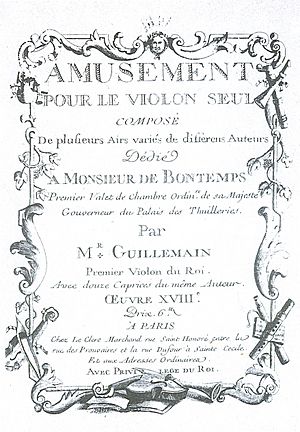Louis-Gabriel Guillemain facts for kids
Louis-Gabriel Guillemain (born November 5, 1705 – died October 1, 1770) was a talented French composer and violin player. He lived during a time when music was very important in royal courts.
Life of a Musician
Louis-Gabriel Guillemain was likely born in Paris, France. He was raised by the Count de Rochechouart. From a young age, Louis-Gabriel began learning to play the violin.
Early Training and Career
To become an even better violinist, Guillemain was sent to Italy. There, he studied with a famous teacher named Giovanni Battista Somis in Turin. By the time he was 24, Guillemain was working in Lyons. He quickly became one of the most popular musicians there. He was even named the first violinist of the Acadèmie de Musique. His very first published work, called Premier livre de sonates, came out in Dijon in 1734. It was a collection of sonatas for violin and basso continuo, which was a common way to play music back then.
Working for the King
Guillemain later moved back to Paris. In 1737, he became a "musicien ordinaire" for Louis XV, the King of France. This meant he was a regular musician for the royal court. His career grew very quickly. By the early 1740s, he was one of the highest-paid musicians at the court. He often performed in private concerts for the King and Queen. He kept publishing his music, and his works were often played at the court in the late 1740s and early 1750s.
Musical Works
Louis-Gabriel Guillemain wrote many pieces of music. Most of his works were published in Paris. Here are some of his known compositions:
- Opus 1: Premier livre de sonates, 12 sonatas for violin and basso continuo (Dijon, 1734)
- Opus 2: XII sonates en trio pour les violons et flûtes, 12 trio sonatas (around 1738)
- Opus 3: Deuxième livre de sonates, sonatas for violin and basso continuo (1739)
- Opus 4: VI sonates for 2 violins (1739)
- Opus 5: Deuxième livre de sonates, sonatas for two violins/flutes (1739)
- Opus 6: VI symphonies dans le goût italien en trio, for 2 violins and basso continuo (1740)
- Opus 7: Six concertinos à quatre parties, for 2 violins, viola, and basso continuo (1740)
- Opus 8: Premier amusement à la mode, for two violins/flutes and basso continuo (1740)
- Opus 9: Pièces for two vielles/musettes/flutes/violins (around 1741), this work is now lost
- Opus 10: Six sonates en trio, for 2 violins and basso continuo (1741)
- Opus 11: Troisième livre de sonates, for violin(s) and basso continuo (1742)
- Opus 12: Six sonates en quatuors ou conversations galantes, for flute, violin, bass viol, and basso continuo (1743)
- Opus 13: Pièces de clavecin en sonates avec accompagnement de violon, 6 pieces for violin and harpsichord (1745)
- L'opérateur chinois, a ballet-pantomime (around 1748)
- Opus 14: Second livre de symphonies dans le goût italien en trio, 6 symphonies for 2 violins and basso continuo (1748)
- Opus 15: Divertissemens de symphonies en trio, for 2 violins and basso continuo (1751)
- Opus 16: Symphonies d'un goût nouveau en forme de concerto pour les musettes, vielles, flûtes ou hautbois (1752), this work is now lost
- Opus 17: Second livre de sonates en quatuor, for flute, violin, bass viol, and basso continuo (1756)
- Opus 18: Amusement pour le violon seul composé de plusieurs airs variés de différens auteurs … avec douze caprices, for solo violin, including pieces by other composers (1762)
Some of Guillemain's other pieces also appeared in music collections of his time.
See also
 In Spanish: Louis-Gabriel Guillemain para niños
In Spanish: Louis-Gabriel Guillemain para niños


